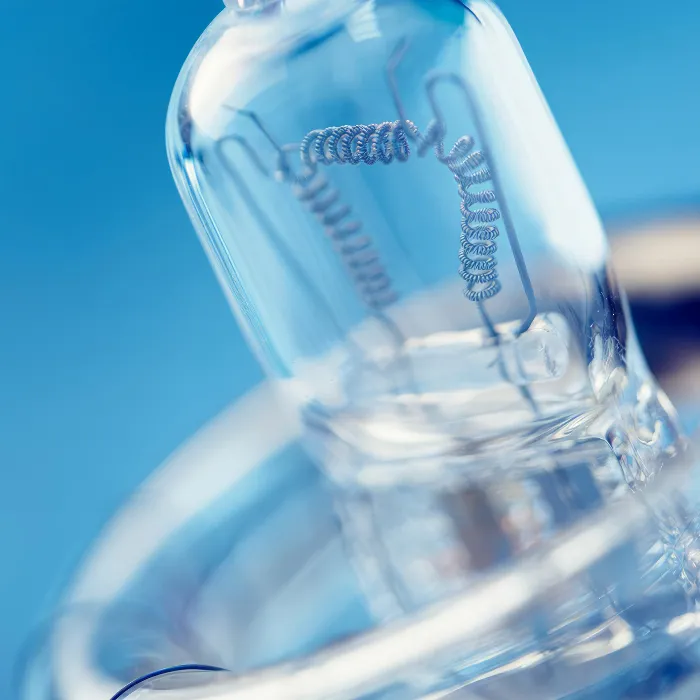5. flash units for indoor and outdoor use?
After I outlined the most important requirements in the previous tutorial (part 4), this part is about which flash systems suitable for professional purposes are suitable for both indoor and outdoor use; i.e. whether there are even devices that cover both areas of use and therefore represent the ideal solution for all those photographers who want to remain flexible and work creatively with artificial light both indoors and outdoors; and (for example due to financial restrictions) cannot purchase two different systems (one for indoor and one for outdoor).
However, it will be necessary to check whether the 2-system solution may be cheaper than purchasing a single system for both different purposes. However, the trend towards ever-increasing mobility is also clearly visible among photographers. Technical innovations are trying to do justice to this fact.
Figure 5.1: If you look at where the sun is in this photo (in the backlight position) and where the main light source illuminating the model must have been (to the left of the camera position, as you can see from the shadows of the legs), it quickly becomes clear that artificial light was also used in this photo. So it would be ideal if photographers could cover all indoor and outdoor applications with just one flash unit. But is there such a thing?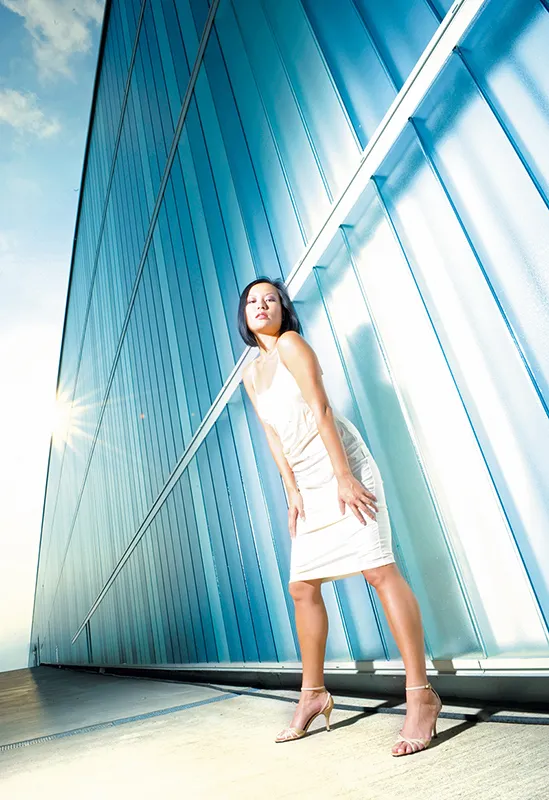
(Photo ©: Jens Brüggemann - www.jensbrueggemann.de)
5.1 Define requirements
Before making a decision when buying a car, you need to consider what kind of car you actually need. If you have to chauffeur a family with 3 children, you are unlikely to opt for a 2-seater sports car. If you only drive on the highway, you should consider whether it really makes sense to buy an off-road vehicle. And if you only drive in urban areas and are dependent on public parking spaces (for example, a real estate agent looking for a company car for this job), you don't need a huge luxury sedan that makes it impossible to park in small parking spaces.
Figure 5.2: A great car! But is it suitable for off-road driving? Or for taking the family of 5 into the city to go shopping? No! As with a car, when buying a flash unit you should find out what it is designed for. Only then will the purchase of a particular speed camera make sense in the long term.
(Photo ©: Jens Brüggemann - www.jensbrueggemann.de)
The situation is similar to buying a car with a flashing system. The designers have a specific purpose in mind for which the flash unit is intended. This does not necessarily mean that it cannot also be used for other purposes; just less optimally (or, in the worst case, not at all). Detailed expert advice is therefore necessary if you want to buy the "right" flash system (i.e. one that is suitable for your intended use).
5.2 Differences in outdoor flash systems
There are just as many differences between outdoor flash systems as there are between cars in the "mid-range" category. There are flash units that are particularly compact and lightweight and can therefore be taken on foot over longer distances.
The Elinchrom Ranger Quadra RX, for example, with a weight of only 2 kg (battery generator without battery) is such a device.
Added to this are the very light lamp heads (250 g each) plus lamp cable, the battery and, as with all systems, the unwieldy tripod. This generator weighs 2.8 kg with a lithium-ion battery and 3.8 kg with a lead-gel battery. The large control range with 6.6 f-stops (400 WS to 8.2 WS) and the small dimensions make the Ranger Quadra RX a great companion wherever you need little weight but still want professional light control.
Figure 5.3: The Ranger Quadra RX from Elinchrom in use at a seminar weekend in Leipzig on the subject of lighting technology (organized by HANSA Computer Leipzig). The Rotalux umbrella was used as the light shaper.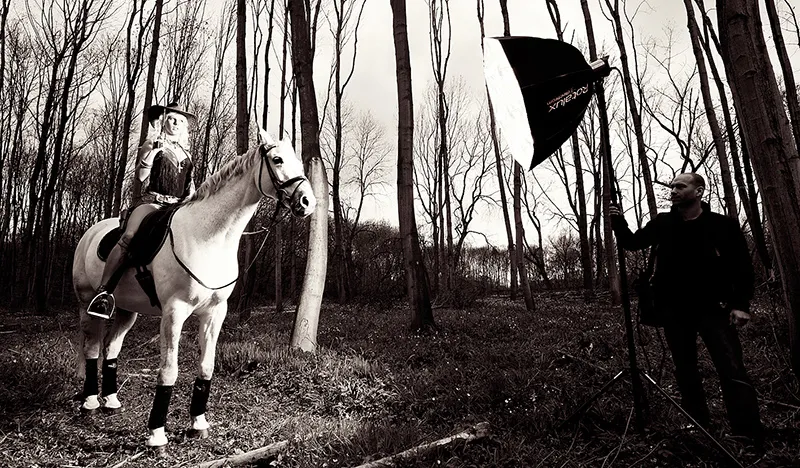
(Photo © 2012: Jens Brüggemann - www.jensbrueggemann.de)
Figure 5.4: And this is the effect: The daylight (the photo was taken in April 2012 at 12:24 noon) was largely flashed away. Horse and model stand out well against the threatening-looking forest.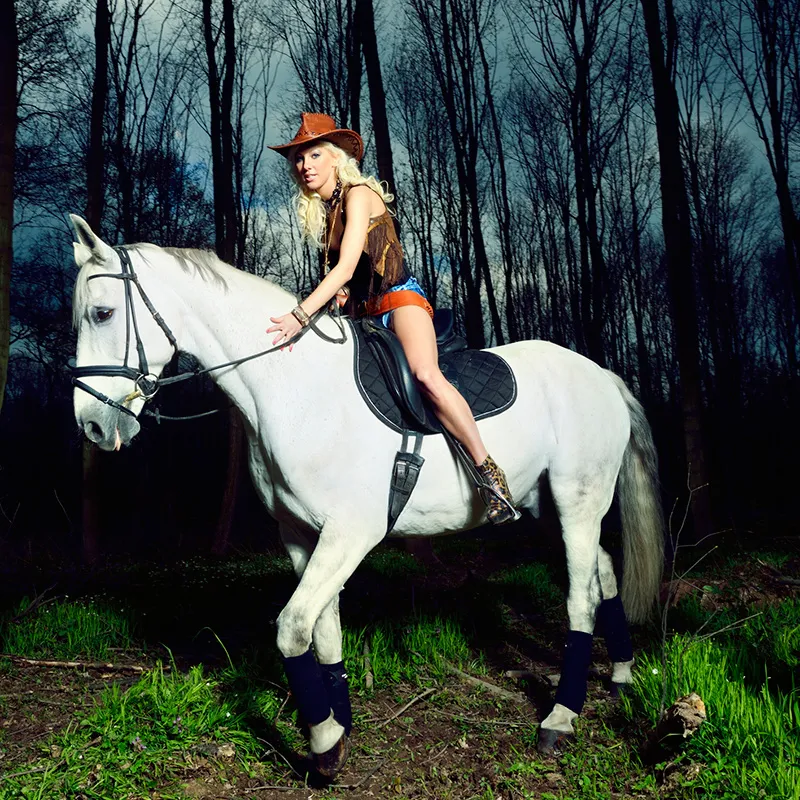
(Photo © 2012: Jens Brüggemann - www.jensbrueggemann.de)
Other outdoor flash units are less handy, but have a higher flash output. This is always important if you want to flash very effectively even in sunlight. High flash output is also particularly important in summer or in southern countries, where lighting conditions differ from those in Germany.
Figure 5.5: If you want to turn night into day, 400 WS will not be enough. In this photo, I used 2,400 WS (broncolor verso A4) to achieve the dramatic effect. Incidentally, vampire films are shot according to the same principle (strongly underexpose daylight until it looks like night; then add strong artificial light for the actors). Take a look at the visually very well-made vampire movie "30 Days of Night"! It's worth it! (What you see there as a full moon is actually the sun).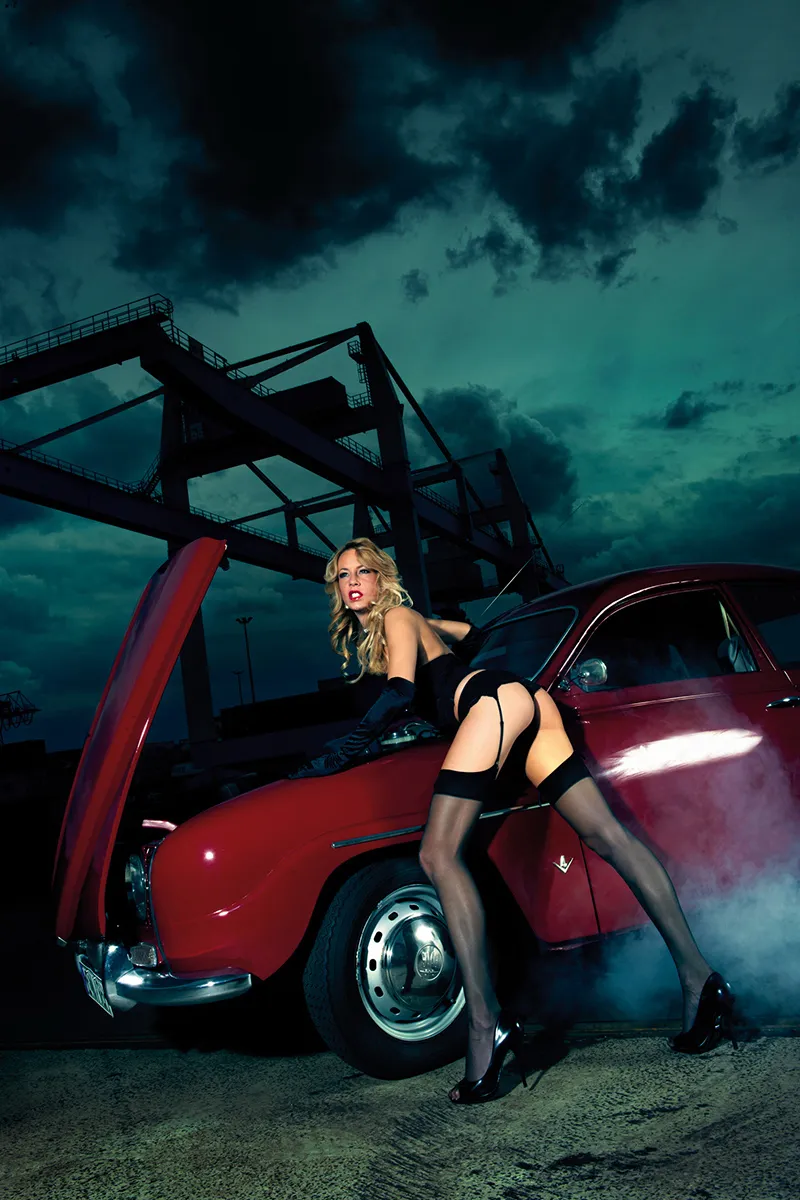
(Photo © 2011: Jens Brüggemann - www.jensbrueggemann.de)
If you attach importance to low weight (for example, because you intend to transport the equipment on an airplane), you should not only compare the weights of the battery generators. Lamp heads, light shapers and especially the lamp cables also have differences in weight that can be noticeable. The overall weight is therefore always the decisive factor.
Anyone purchasing outdoor generators will also want them to be robust, dustproof and splashproof. So it makes sense not just to buy according to pictures on the Internet, but to look at the devices in person.
But it's not just performance and (light) weight that are important for outdoor flash units. Before purchasing, you should also consider whether the generator should only have one or better two (or even three) light connections. And if it has several light connections: How can the outputs of these two be controlled? Individually ("asymmetrically")? Or only in a certain ratio (as with most devices)? (With the Ranger Quadra RX Hybrid, for example, the power distribution from luminaire connection 1 to luminaire connection 2 is 2:1).
Of course, handling also plays an important role, as does the time it takes to recharge the battery. The shorter the time, the sooner the battery generator is ready for use again. With newer systems such as the Profoto Pro-B4, the battery can even be charged during operation, which makes the generator particularly interesting as an all-round device.
Note: It should be noted, however, that batteries eventually "give up the ghost". Some premium manufacturers (e.g. broncolor) claim up to 4,000 charging cycles (e.g. for the new broncolor move 1,200 L battery generator). In practice, however, this value is probably not quite achievable. With "cheaper" solutions, this high number of charging cycles is not even close to being achieved. Continuous use, even in the studio, is therefore just as impractical as long periods of non-use, which would damage the capacitors.
5.3 Squaring the circle
Anyone who prefers a flash system with fast, long-lasting flash sequences, as required in fashion photography for example, will find it difficult to find one that is equally suitable for both purposes (indoor and outdoor), because fast flash readiness with long series is at the expense of battery capacity, which in turn restricts photographers (or means that expensive and possibly heavy replacement batteries have to be lugged around).
Anyone who requires a strong modeling light in order to be able to judge the light curve to some extent even in mixed light will also have a problem finding a system that is equally suitable for indoor and outdoor use, as a very strong modeling light would drain the battery far too quickly.
If you attach importance to controlling 3 or even 4 flash heads with just one generator, you will not find a flash system that is suitable for outdoor use, because 3 (or even 4) light connections make the generator too heavy and bulky and therefore quite unsuitable for mobile applications.
If you need a lot of power, you can - theoretically - buy a battery-powered flash unit that fulfills this requirement; however, the dimensions and weight (for example, over 26 kg for the broncolor verso A4) make the generator anything but mobile and "suitable for off-road use".
The same applies to the equipment: many additional functions make the generator heavier and more unwieldy and therefore less and less suitable for mobile outdoor flashing.
Note: As you can see from the above examples, the requirements placed on studio flash units and battery-powered flash units (mobile flash units) are sometimes contradictory. For technical reasons, it is not possible to build an all-terrain Formula 1 racing car with a fuel consumption of 3.0 liters per 100 kilometers. Some requirements are mutually exclusive.
5.4 Egg-laying woolly milk sows?
Many requirements for battery generators are difficult to reconcile, as I have just shown you. However, there are interesting new developments that have taken into account the wishes of many photographers for mobility and maximum flexibility. What seemed unthinkable three or four years ago has now become reality.
At this point, I would like to introduce you to two recommendable devices that take a different approach, but ultimately achieve the same thing: Flexibility in terms of where they can be used. In short: they are (almost equally) suitable for indoors and outdoors. Whether they are completely without restrictions will be shown below ...
5.4.1 Profoto Pro-B4 battery generator
The Profoto Pro-B4 is the most interesting new release in the field of professional lighting technology and seems to me to best deserve the title "egg-laying wool-milk sow":
Technical data Profoto Pro-B4
- 1,000 watt-seconds maximum output
- Wide control range over 11 f-stops (from 1,000 WS to 1 WS); adjustable in full or 1/10 f-stops (to get below 3.9 WS, the generator must be switched to "freeze" mode)
- 220 flashes under full load
- only 45 minutes charging time
- individually asymmetrical setting options for 2 lamp heads (in 1/10 f-stop increments)
- Dust and splash-proof (if Pro Plus lamp heads are used)
- Up to 500 watt modeling light possible (or 2x 250 watt)
- Very short flash duration of up to 1/25,000 second
- Very fast charging times; 0.03 to 0.99 seconds depending on power output
- Weight 9.8 kg including lithium-ion battery
- Dimensions: 31.5cm x 18cm x 25cm
- Can be charged during operation
- integrated radio remote control module up to 300m range
- enables up to 30 flashes/second
Further information at: http://www.profoto.com/de/generatoren/pro-b4-1000-air
Figure 5.6: At almost 10 kg, this battery generator is not exactly a lightweight. However, it also offers a lot of interesting features. In particular, its fast charging cycles and its large control range over 11 f-stops make this outdoor generator look good in the studio too!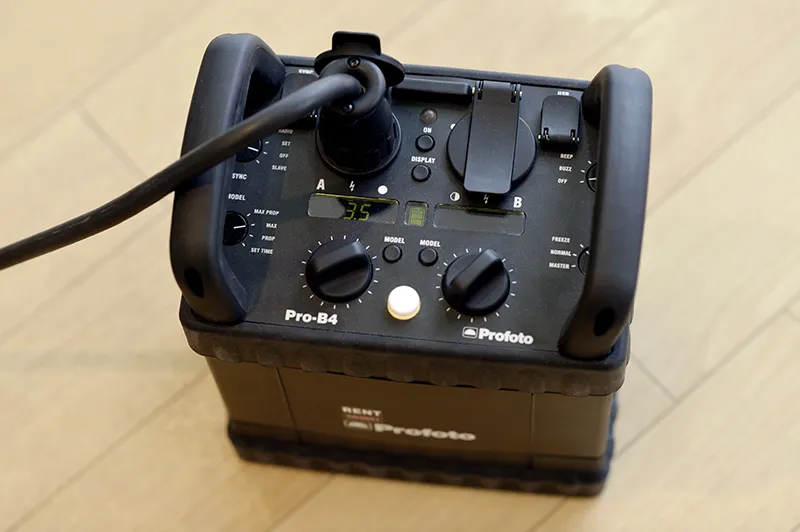
(Photo © 2013: Jens Brüggemann - www.jensbrueggemann.de)
The Profoto Pro-B4 is particularly interesting because it is really flexible to use. It was designed as an outdoor generator, but the ability to quickly charge the battery in just 45 minutes and the option of continuing to operate the generator while it is charging means that it can also be used in the studio. However, it cannot be regarded as a fully-fledged studio generator on its own because it only has two light connections.
The classic lighting setup with main light, effect light and background light is not feasible with just one device.
Added to this is the "proud" price: at EUR 6,250.00 plus VAT (= EUR 7,437.50 gross) for the generator including 1 battery and charger (Calumet price from 12.04.2013), the generator is not exactly a "bargain". Newcomers who do not yet own any Profoto light heads will have to buy 2 Profoto Pro Plus heads, which will then cost a further €1,675.00 plus VAT (= €1,993.25 gross) per head.
Together, this amounts to 9,600.00 euros plus VAT (= 11,424.00 euros) for 1 generator housing, 1 battery, 1 charger and 2 light heads. Light shapers, tripods and transport case are extra.
Conclusion
The Profoto Pro-B4 is what is known as "state of the art". It is the first choice for professionals who are looking for a very robust, reliable outdoor generator and also want to use it flexibly in the studio. However, the price is likely to put off non-commercial amateurs, unless they already have Profoto light heads, so that they can stick to buying just the generator.
One thing should also be borne in mind: Not long ago, several units had to be purchased in order to be able to flash professionally both indoors and outdoors. The Profoto Pro-B4 combines these possibilities in one device.
However, there are some limitations: With only 2 light connections, it will not remain an "only child" for long, at least for indoor shoots; in addition, you will have to purchase another flash head in the medium term in order to be able to realize light setups with at least three lights. Even if most of my photos were taken with just one or two lights: Especially for commissioned shoots, you can't do without having one or two more lights up your sleeve.
The Pro-B4 should be seen as a long-term investment, as Profoto is known for the longevity of its lighting technology (compared to broncolor). If you apply the acquisition costs to the expected service life of two or three decades (depending on use), it becomes clear that the purchase can also be viewed quite pragmatically for "cool calculators" - and is certainly not a "luxury".
5.4.2 Priolite compact flash units
The Priolite company takes a completely different and very interesting approach. It produces compact flash units that no longer need to be connected to a power socket using a power cable. The compact flash units run on battery power and are therefore generally suitable for both indoor and outdoor photo shoots.
Figure 5.7: No mistake, no retouching: The Priolite compact flash units really do not have a power cable! They are battery-operated. They only need to be plugged into a socket for charging.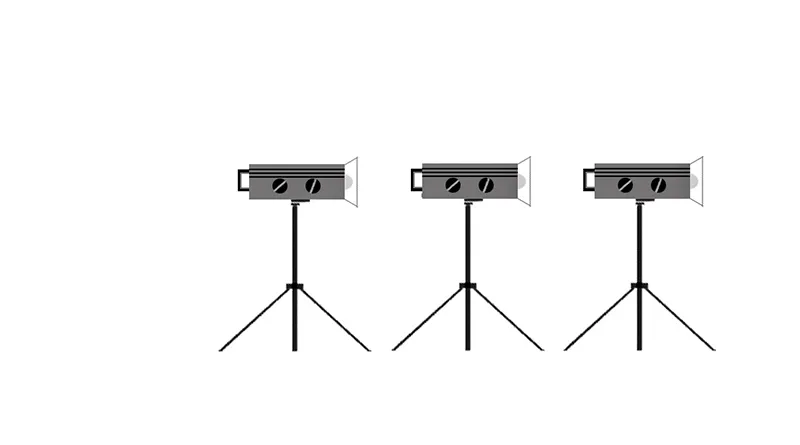
Technical data Priolite MB500
- 500 watt seconds maximum output
- Control range over 5 f-stops; adjustable in whole or 1/10 f-stops
- Up to 400 flashes under full load
- Charging time: 2.5 hours to 80%
- 100 watt modeling light equivalent, via LED array
- Special feature: bidirectional remote control module with many functions
- (relatively slow) charging time to 500 WS: 3 seconds
- Weight: 4.2 kg including lithium-ion battery
- Dimensions: 40cm x 17cm x 17cm
- Battery charge cycles: up to 1,000
- 3 flash options: Xenon flash, LED flash, combination of Xenon flash and LED flash
- Xenon flash color temperature: 5,600 K; LED flash color temperature: 6,500 K
Further information at: http://www.priolite.com/de/produkte/details-priolite/items/priolite-mb500.html
Figure 5.8: The battery-operated Priolite compact flash units are ideal for all photographers who tend to trip over power cables ...! Or want to use the flash unit both indoors and outdoors.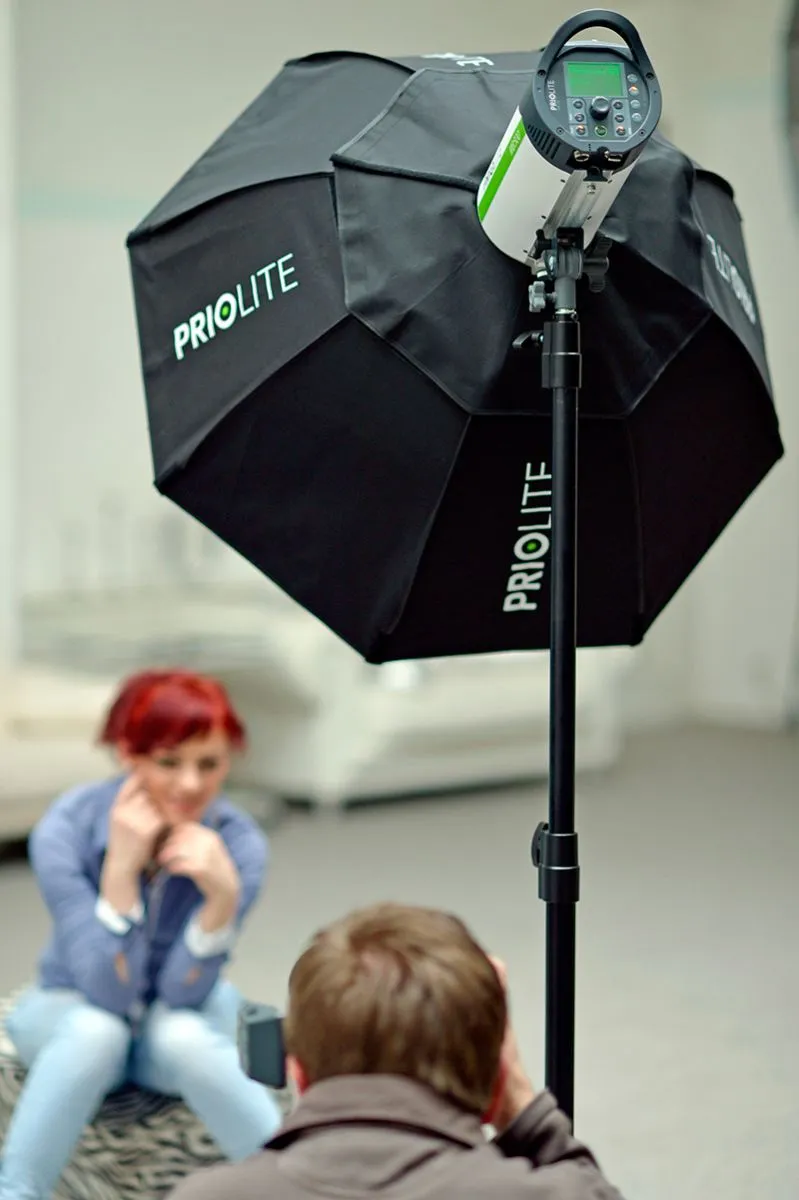
(Photo © 2013: Jens Brüggemann - www.jensbrueggemann.de)
The number of charging cycles for the battery of the Priolite MB500 is specified by the manufacturer as 1,000. Up to 400 flashes can be fired at full power (500 WS) per charging cycle (depending on the ambient temperature, the speed of the flash sequences, modeling light use, etc.).
As the battery in this model is permanently installed, it is not possible to use a spare battery for outdoor shooting or to replace it yourself at the end of its service life. The Priolites MB500 must therefore be sent to the workshop if the battery is defective or exhausted, where the battery is then replaced. This may seem cumbersome, but the manufacturer has certainly thought about it: "A replacement mechanism would mechanically enlarge the device.
To do this, the battery has to be encased again and a replacement mechanism developed. We did not go down this route in order to keep the device compact. Replacing a battery in an authorized Priolite workshop costs Euro 220.00 net."
For semi-professional photographers with (assumed) an average of two photo shoots (= charging cycles) per week (a full battery charge is calculated for each shoot), the Priolites can easily last 8-12 years before the battery needs to be replaced.
Figure 5.9: This front view of the MB500 shows the LED array, which is positioned in the middle of the flash tube included in the scope of delivery. Also clearly visible is the reflector mechanism, which accommodates Bowens S and many Hensel light shapers in addition to the Priolite reflectors.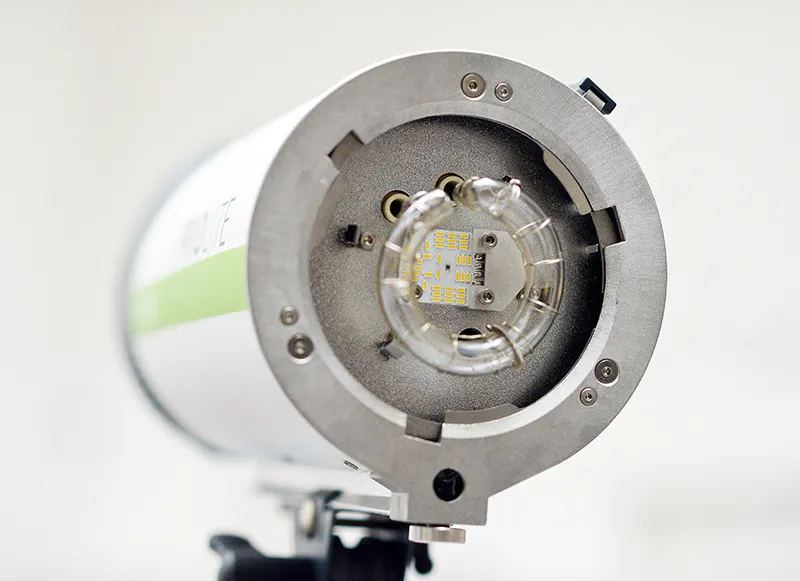
(Photo © 2013: Jens Brüggemann - www.jensbrueggemann.de)
The purchase price for the MB500 model is a moderate 920.00 euros plus VAT (= 1,094.80 euros gross). (The scope of delivery includes flash tube, LED modeling light array, protective glass cover, charger and sync cable). With 3 compact flash units, which it makes sense to buy in order to meet the majority of photographic requirements, the total purchase price is 2,760.00 euros plus VAT (= 3,284.40 euros gross). Added to this are various light shapers, light stands, transport case and the recommended remote control module amounting to 150.00 euros plus VAT (= 178.50 euros gross). (Prices: Achatzi.de from 03.04.2013).
Figure 5.10: The remote control module for the Priolite compact flash units may look quite "powerful", but it offers the photographer a whole host of functions. "Almost all functions of the device can be controlled remotely. The power of the unit and its flash readiness are displayed on the remote control," says the manufacturer. Up to 36 devices can be individually remote-controlled.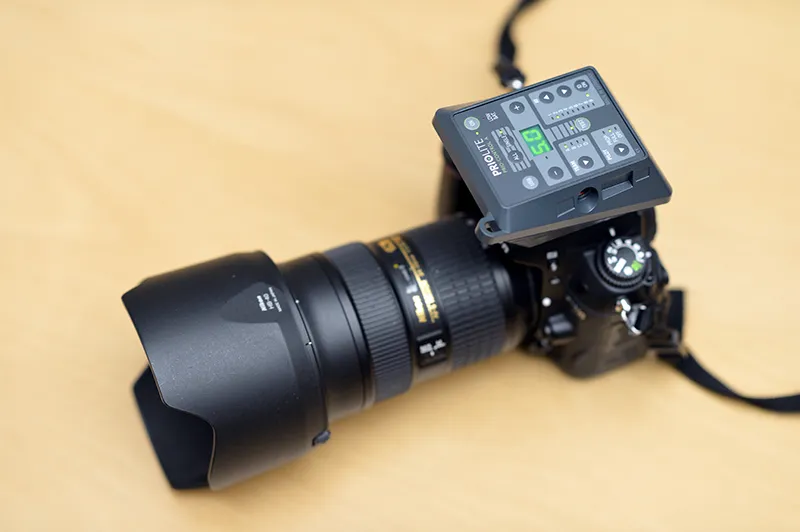
(Photo © 2013: Jens Brüggemann - www.jensbrueggemann.de)
Conclusion on the subject
The still young company Priolite (by the way, the devices are completely "Made in Germany") is pursuing an interesting concept with its battery-powered compact flash units, which should be of particular interest to newcomers who want to use flash creatively both indoors and outdoors.
For fully professional users, however, the control range (currently five f-stops) should be increased. An even stronger modeling light for photo shoots in mixed light situations would also be desirable. Apart from that, however, the devices really do have everything they need to provide the photographer with flexible support for a wide variety of photo assignments. The Priolites have therefore also earned the title of "egg-laying woolly milk sows".
If you don't trust the principle of a permanently installed battery, you can opt for another model in the Priolite series. For example, the battery in the MBX500 can be removed/replaced via a removable drawer. Although it has less capacity ("only" up to 220 flashes under full load of 500 WS), it makes the compact flash significantly lighter. The MBX500 weighs only 3.2 kg with the battery inserted, which is interesting for anyone who wants to use the device mainly outdoors. Every 100g of weight saved counts. Not only during transportation, but also on the tripod at lofty heights when the wind (for example during a photo shoot by the sea) causes the flash and light shaper to sway.
As the Priolite reflector mechanism is also compatible with the connections of other reflector manufacturers (Bowens-S and many Hensel reflectors) (without an additional external adapter), their extensive range of light shapers can also be used.
The pricing can be described as moderate for such innovative devices. As they can be purchased individually, if you are on a tight budget you can start with 2 devices. The equipment can then be gradually expanded to include a 3rd or 4th device and additional light shapers.
Preview
In the next part (Part 6: Alternatives) of this tutorial, you will find out what alternatives there are to these "egg-laying woolly mammals"! Because there are also other solutions for working with flash systems both indoors and outdoors.
